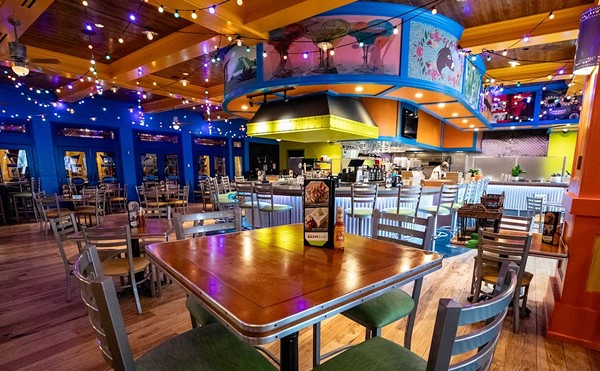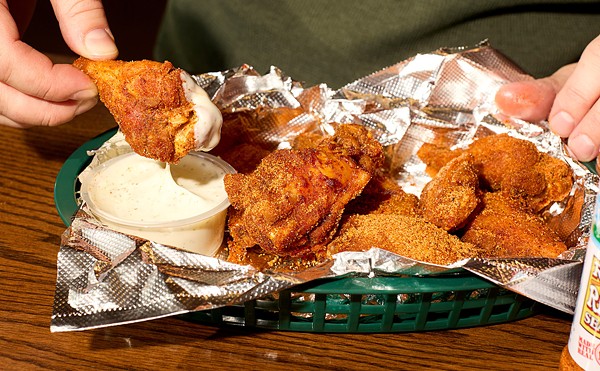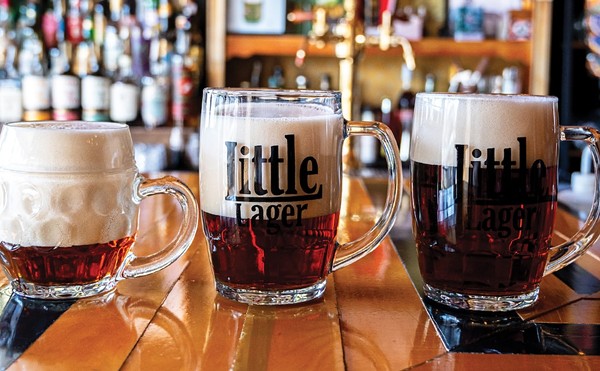Flash forward a couple of weeks: The Bonwich clan is all psyched up for a visit to old family favorite Lemmons to see whether the new incarnation had retained the secret recipe for fried chicken. They haven't. It's now much more of a bar and music venue; the only food is the pizza made famous by the new owners at their original place on Wyoming, the Black Thorn Pub. (If you miss the inimitable prose of our esteemed former colleague Jill Posey-Smith, you can find a giggle-icious view of the new Black Thorn at Lemmons, plus other fun and games, online at her new Web site, www.twistyfaster.com.)
We, however, could not see dragging out an entire column on one restaurant's pizza, and after recalling our friend's thoughts on Giuseppe's, we set out for Grand Boulevard. What we found was a classic Italian-American place, perfectly preserved from the 1970s, full of patrons decked out in their Sunday best and others out for a simple, casual dinner.
Entering at the corner at Grand, we walked into a lounge and waiting area where we halfway expected to see Dean Martin nursing a drink in a corner, microphone in hand; we were then escorted through three or four dining rooms before being seated in the very back. Tables were clothed in white linen, the waitresses in black-and-white uniforms; the walls were lined with gilt-framed, top-lit, over-the-couch Renoiresque paintings -- if he'd discovered a time machine and managed to get Elke Sommer to pose on a Parisian boulevard. The busperson's fluorescent hair streaks were the only real giveaway that that was then and this is now.
The meal that followed was filled with good, solid, elegantly simple Italian-American food: An antipasto plate of mortadella, coppa and salami from Manzo Importing; green olives; pickled pepperoncini; garlic-dressed artichoke hearts; thick slices of tomato (remarkably good for this time of year); and lots of salty anchovy. A fried-vegetable plate, with light breading on the outside and still-crisp broccoli, cauliflower and artichokes, plus mushrooms and eggplant, on the inside. Straightforward pastas such as linguini with clam sauce. Thin slices of eggplant in tomato sauce and Parmesan cheese. Six large shrimp in a thick marinara. "Sicilian" salmon, a thick rectangular bar of the fillet, served with a cool relish of crushed tomato and garlic.
Wash it down with one of more than 50 wines, almost all well under $40, and you'll leave full and happy, as just about everyone has since the restaurant's inception as a four-seat pizza place some 27 years ago. It was owned then, and still is, by Giuseppe Pugliese and his wife, Antonia, immigrants from Campobello di Mazara, Sicily. After he came over in the late '50s, Giuseppe worked at Rose's, downtown at 10th and Franklin, until that was torn down to make way for the convention center. Many of his customers followed him to his new place, which he upgraded gradually until it finally ran out of expansion space.
Al Smith's Feasting Fox, catty-corner at the same intersection, has been a Dutchtown landmark much longer, dating to its opening as Busch's Gretchen Inn in 1913, the year of patriarch Adolphus Busch's death. After Prohibition, Anheuser-Busch was legally enjoined from owning bars and restaurants, and the ornate Bavarian structure was turned into Al Smith's Restaurant, run by Al Smith until 1961 and subsequently by his managers, Fred and Evelyn Krumm. Even as recently as the late '70s and early '80s, Al Smith's was a destination for cold beer and the weekly all-you-can-eat fried-chicken special.
In the mid-'90s, the building was slated to be replaced by a Jack in the Box or some similar architecturally significant structure when neighborhood activists and preservationists managed to get the building donated to the Dutchtown South Neighborhood Association for tax credit. (We can but hope that the current saga of the South Side National Bank building at Grand and Gravois, which is riffing on a similar theme, has the same happy ending.)
The current owners are Sue and Marty Luepker, and in addition to achieving the major feat of restoring a building that stood vacant for almost eight years, they've turned the place into a shrine to other St. Louis restaurants that have gone to that great dishwasher in the sky. All around the interior of the Feasting Fox (whose name comes from an icon on the side of the A-B brewery) are remnants of such past haunts as Nantucket Cove, Dohack's, Famous-Barr's Clayton dining room and the Top of the 230. The dining rooms and bar also sport various vintages of primarily beer-related kitsch from A-B and from many vanquished competitors, ranging from Falstaff to much smaller regional brewers. Look closely in the corner of the bar area and you'll see that the traditional proscription against shoelessness and shirtlessness has been replaced by a ban on "skulking loafers and fleabitten tramps."
The menu doesn't seem to have changed much since we first visited after the reopening several years ago. The Fox features reasonably priced (nothing except a steak or two over $15, and a whole lot under $10) eclectic Continental cuisine, with German and Austrian dishes represented in about half-a-dozen appetizers and entrées.
We're still impressed by the range of flavors -- sweet apple, tart dried and reconstituted cherries, tangy cider vinegar -- in the Black Forest sweet-and-sour pork with spätzle, but we'd have liked more of the main ingredient, cubed pork loin, in the mix. And befitting the Al Smith heritage, the simple half-chicken is wonderful. We ordered the rotisserie version (fried is still offered as well), which featured a hot, crisp skin layer coated with a thin layer of barbecue sauce and warm but not searing moist flesh underneath
The contents of the "house specialty" plate, beer-battered onion rings, were quite crisp inside, and we suppressed our indignant Polish pride when informed that the German-sausage sampler we were eating included, in addition to bratwurst and a phyllo-wrapped house sausage, a Krakow and a kielbasa. Hey, you say Danzig, we say Gdansk. No need to call the whole thing off.
Toss in a little homemade apple strudel for dessert -- lots of apple, just enough pastry -- and the result is a destination worth seeking out from all corners of the metro area.
A bit of PR advice for the re-emerging neighborhood: This particular stretch of South Grand is still dotted with food-related gems, ranging from Eastern European grocers to the original Ted Drewes to Merb's Candies to a Vietnamese sandwich shop. Driving and walking around gave us no pause -- until we caught sight of a sign on the door of the apartment building immediately west of Giuseppe's forbidding drug dealing and other illegal activity.
Now, you can just imagine the conversation among the prospective tenants: "Oh John, I've found the cutest little apartment upstairs. Come and look!"
"Sorry, Mary, but the sign on the door says 'No Drug Dealing.' I may be a dope dealer, but I always read and obey signs, by golly!"
"Oh John, I do love you for your sense of honor!"
Sheesh. Luckily, folks such as the Puglieses and the Luepkers have taken a more head-on approach to neighborhood revitalization. Yes, Giuseppe's is still going strong after all these years. Yes, Al Smith's is back and thriving in its new form. Cruise on down to Grand and Meramec for a living-history presentation of St. Louis dining and hospitality.





